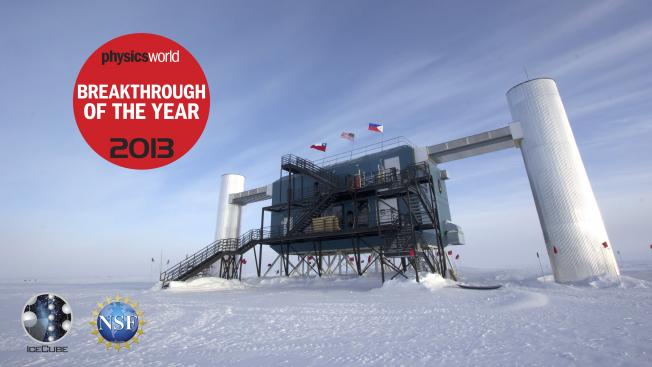Searches for relativistic magnetic monopoles in IceCube
European Physical Journal C (2016)
Abstract:
© 2016, The Author(s).Various extensions of the Standard Model motivate the existence of stable magnetic monopoles that could have been created during an early high-energy epoch of the Universe. These primordial magnetic monopoles would be gradually accelerated by cosmic magnetic fields and could reach high velocities that make them visible in Cherenkov detectors such as IceCube. Equivalently to electrically charged particles, magnetic monopoles produce direct and indirect Cherenkov light while traversing through matter at relativistic velocities. This paper describes searches for relativistic ((Formula presented.)) and mildly relativistic ((Formula presented.)) monopoles, each using one year of data taken in 2008/2009 and 2011/2012, respectively. No monopole candidate was detected. For a velocity above (Formula presented.) the monopole flux is constrained down to a level of (Formula presented.). This is an improvement of almost two orders of magnitude over previous limits.The prompt atmospheric neutrino flux in the light of LHCb
JHEP Springer Berlin Heidelberg 02:2 (2016) 130
Abstract:
The recent observation of very high energy cosmic neutrinos by IceCube heralds the beginning of neutrino astronomy. At these energies, the dominant background to the astrophysical signal is the flux of `prompt' neutrinos, arising from the decay of charmed mesons produced by cosmic ray collisions in the atmosphere. In this work we provide predictions for the prompt atmospheric neutrino flux in the framework of perturbative QCD, using state-of-the-art Monte Carlo event generators. Our calculation includes the constraints set by charm production measurements from the LHCb experiment at 7 TeV, and has been recently validated with the corresponding 13 TeV data. Our results for the prompt flux are a factor of about 2 below the previous benchmark calculation, in general agreement with two other recent estimates, and with an improved estimate of the uncertainty. This alleviates the existing tension between the theoretical prediction and IceCube limits, and suggests that a direct direction of the prompt flux is imminent.Characterization of the atmospheric muon flux in IceCube
Astroparticle Physics Elsevier 78 (2016) 1-27
Abstract:
Muons produced in atmospheric cosmic ray showers account for the by far dominant part of the event yield in large-volume underground particle detectors. The IceCube detector, with an instrumented volume of about a cubic kilometer, has the potential to conduct unique investigations on atmospheric muons by exploiting the large collection area and the possibility to track particles over a long distance. Through detailed reconstruction of energy deposition along the tracks, the characteristics of muon bundles can be quantified, and individual particles of exceptionally high energy identified. The data can then be used to constrain the cosmic ray primary flux and the contribution to atmospheric lepton fluxes from prompt decays of short-lived hadrons. In this paper, techniques for the extraction of physical measurements from atmospheric muon events are described and first results are presented. The multiplicity spectrum of TeV muons in cosmic ray air showers for primaries in the energy range from the knee to the ankle is derived and found to be consistent with recent results from surface detectors. The single muon energy spectrum is determined up to PeV energies and shows a clear indication for the emergence of a distinct spectral component from prompt decays of short-lived hadrons. The magnitude of the prompt flux, which should include a substantial contribution from light vector meson di-muon decays, is consistent with current theoretical predictions. The variety of measurements and high event statistics can also be exploited for the evaluation of systematic effects. In the course of this study, internal inconsistencies in the zenith angle distribution of events were found which indicate the presence of an unexplained effect outside the currently applied range of detector systematics. The underlying cause could be related to the hadronic interaction models used to describe muon production in air showers.Search for correlations between the arrival directions of IceCube neutrino events and ultrahigh-energy cosmic rays detected by the Pierre Auger Observatory and the Telescope Array
Journal of Cosmology and Astroparticle Physics IOP Publishing 2016:1 (2016) 037-037
Abstract:
This paper presents the results of different searches for correlations between very high-energy neutrino candidates detected by IceCube and the highest-energy cosmic rays measured by the Pierre Auger Observatory and the Telescope Array. We first consider samples of cascade neutrino events and of high-energy neutrino-induced muon tracks, which provided evidence for a neutrino flux of astrophysical origin, and study their cross-correlation with the ultrahigh-energy cosmic ray (UHECR) samples as a function of angular separation. We also study their possible directional correlations using a likelihood method stacking the neutrino arrival directions and adopting different assumptions on the size of the UHECR magnetic deflections. Finally, we perform another likelihood analysis stacking the UHECR directions and using a sample of through-going muon tracks optimized for neutrino point-source searches with sub-degree angular resolution. No indications of correlations at discovery level are obtained for any of the searches performed. The smallest of the p-values comes from the search for correlation between UHECRs with IceCube high-energy cascades, a result that should continue to be monitored.THE SEARCH FOR TRANSIENT ASTROPHYSICAL NEUTRINO EMISSION WITH ICECUBE-DEEPCORE
Astrophysical Journal (2016)



